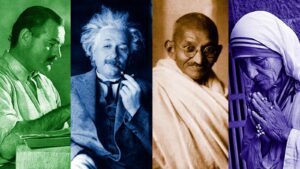What is the Keirsey ENFP “Champion” Personality Type?
The Keirsey ENFP “Champion” personality type is an Idealist Temperament with abstract communication and cooperative action styles.
Keirsey organized the Four Temperaments as a matrix. There are two communication styles, abstract and Concrete, similar to the Myers-Briggs Intuition (Abstract) and Sensing (Concrete) “Perceiving” Cognitive Functions.
And by two action styles: cooperative and utilitarian. Utilitarian people, for the most part, do what works, while Cooperative people do what’s right.
Keirsey named the Four Temperaments as suggested by Plato: Artisan (Iconic), Guardian (Pistic), Idealist (Noetic), and Rational (Dianoetic).

Concrete versus Abstract Communication Style
Keirsey divided the Four Temperaments into two Communication Styles: Abstract and Concrete. These styles resemble the Myers-Briggs Intuition and Sensing “Perceiving” Cognitive Functions.
Some people talk primarily about everyday reality’s external, concrete world: facts and figures, work and play, home and family, news, sports, and weather—all the who, what, when, where, and how of life.
Other people talk primarily about the internal, abstract world of ideas: theories and conjectures, dreams and philosophies, beliefs and fantasies—all the whys, ifs, and what might be of life.
Concrete people talk about reality daily, while Abstract people talk about ideas.
According to Keirsey, everyone can engage in both observation and introspection. People are observant when they touch objects or otherwise perceive the world through their five senses.
When people reflect and focus on their internal world, they are introspective. However, individuals cannot engage in observation and introspection simultaneously. The extent to which people are more observant or reflective affects their behavior.
People who are generally observant are more ‘down to earth.’ They are more concrete in their worldview and focus on practical matters such as food, shelter, and their immediate relationships. Carl Jung used the word sensation when describing people who prefer concrete perception.
Generally, reflective people have more ‘heads in the clouds’ and abstract worldviews. They focus on global or theoretical issues such as equality or engineering. Carl Jung used the word intuition to describe people who prefer abstract perception.
Cooperative versus Utilitarian Action Style
Some people act primarily practically or pragmatically; that is, they do what gets results, what achieves their objectives as effectively or efficiently as possible. They only check afterward to see if they observe the rules or go through the proper channels.
Other people act primarily cooperatively or socially acceptable; they try to do the right thing in keeping with agreed-upon social rules, conventions, and codes of conduct. Only later do they concern themselves with the effectiveness of their actions.
These two ways of acting can overlap, but as they lead their lives, Utilitarian people mostly do what works, while Cooperative people do what’s right.
Keirsey compares the differing temperaments with cooperative (Complying) and pragmatic (Adaptive) temperaments. Cooperative people pay more attention to other people’s opinions and are more concerned with doing the right thing. Sensible people (Utilitarian) pay more attention to their thoughts or feelings and are more concerned with doing what works. No comparable idea in the MBTI or Jung corresponds to this dichotomy, which is a significant difference between Keirsey’s work and Myers and Jung’s.
The pragmatic temperaments are Rational (pragmatic and abstract) and artisan (Pragmatic and concrete). The Cooperative Temperaments are Idealists (Cooperative and Abstract) and Guardians (Cooperative and Concrete). Neither the MBTI nor Jung included the concept of Temperament in their work.
ENFP Keirsey/MBTI Correlation
| Keirsey | MBTI | |
|---|---|---|
| E | Attentive Role Variant | Introverted Feeling |
| N | Abstract Communication Style | Extraverted iNtuition Dominate Function |
| F | Cooperative Action Style | Introverted Feeling Auxiliary Function |
| P | Utilitarian Role | Intuition is a Perceiving Function |
With Extraverted Intuition as the first Dominant Function and Introverted Feeling as the second Auxiliary Function, the MBTI ENFP “Champion” Personality Type is similar to the Keirsey ENFP “Champion” Personality Type.

ENFP Personality Type Cross-reference
- Keirsey Type – Champion
- Temperament Type – Phlegmatic
- Animal Type – Otter
- DISC Type – Influential
- Socio-Communicative Type – Expressive
- True Colors – Blue
- Color Code – Blue
- Personality Compass – West
- Occupational Type – Artistic
- Learning Type – Theorist
- Leadership Type – Collaborator
Enneagram Types
Champion Personality Characteristics
Like the other Idealists, Champions are relatively rare, say two or three percent of the population, but even more than the others, they consider intense emotional experiences vital to a whole life.
Champions have a wide range and variety of emotions and a great passion for novelty.
They see life as an exciting drama, pregnant with possibilities for both good and evil, and they want to experience all the meaningful events and fascinating people in the world.
The most outgoing of the Idealists, Champions often can’t wait to tell others of their extraordinary experiences.
Champions can tirelessly talk with others, like fountains that bubble and splash, spilling over their words to get it all out. This talk is usually not simple storytelling; champions often speak (or write) to reveal some truth about human experience or motivate others with their potent convictions.
Their strong drive to speak out on issues and events, boundless enthusiasm, and natural language talent make them the most vibrant and inspiring of all types.
Fiercely individualistic, Champions strive toward personal authenticity, and this intention to be themselves is usually quite attractive to others.
At the same time, Champions have outstanding intuitive powers and can tell what is happening inside of others, reading hidden emotions and giving special significance to words or actions.
Champions constantly scan the social environment; no intriguing character or silent motive will likely escape their attention.
Far more than the other Idealists, Champions are keen and probing observers of the people around them and are capable of intense concentration on another individual.
Their attention is rarely passive or casual. On the contrary, Champions tend to be extra sensitive and alert, always ready for emergencies and looking for what’s possible.
Champions are good with people and usually have many personal relationships.
They are warm and full of energy with their friends.
They are likable and at ease with colleagues and handle their employees or students with great skill.
They are good in public and on the telephone and are so spontaneous and dramatic that others love to be in their company.
Champions are positive, exuberant people; their confidence in the goodness of life and human nature often makes good things happen.
Famous Champions
Joan Baez, Phil Donahue, Paul Robeson, Bill Moyer, Elizabeth Cady Stanton, Joeseph Campbell, Edith Wharton, Sargent Shriver, Charles Dickens, and Upton Sinclair are examples of Idealist Champions.

What are the Keirsy Personality Temerpaments?

David Keirsey, born in 1921, was an American psychologist specializing in conflict management and family counseling. He began researching human behavior and Personality in the 1940s.
Keirsey blended the Myers-Briggs Personality Types with Ernst Kretschmer’s model of the Four Temperaments, developing the Keirsey Temperament Sorter, which was made famous by his book “Please Understand Me.”
Instead of using the term Personality, Keirsey used Temperament. He viewed it as a configuration of observable Personality Traits, communication habits, patterns of action, characteristic attitudes, values, and talents. To Keirsy, Temperament encompasses personal needs, individual contributions, workplace contributions, and societal roles.
Keirsey correlated the sixteen MBTI Personality Types into Four Temperaments. He divided each Temperament into two Roles: informative and Directive. He subdivided the roles into expressive (extraverted) and attentive (introverted) role Variables.
Informative versus Directive Roles
Keirsey distinguishes between people who generally communicate by informing others versus those who speak by directing others. This distinction subdivides each of the four Temperaments into eight Roles.
Expressive versus Attentive Role Variants
Individuals who act before observing are Expressive. In contrast, people who follow before working are Attentive.
Expressive and attentive variants further subdivide the eight roles into 16 types correlating to the 16 Myers-Briggs personality types.


